Our guide to choosing a bathroom radiator - avoid the dreaded post-shower shivers with these rules to follow
Everything you need to consider before buying a new bathroom radiator
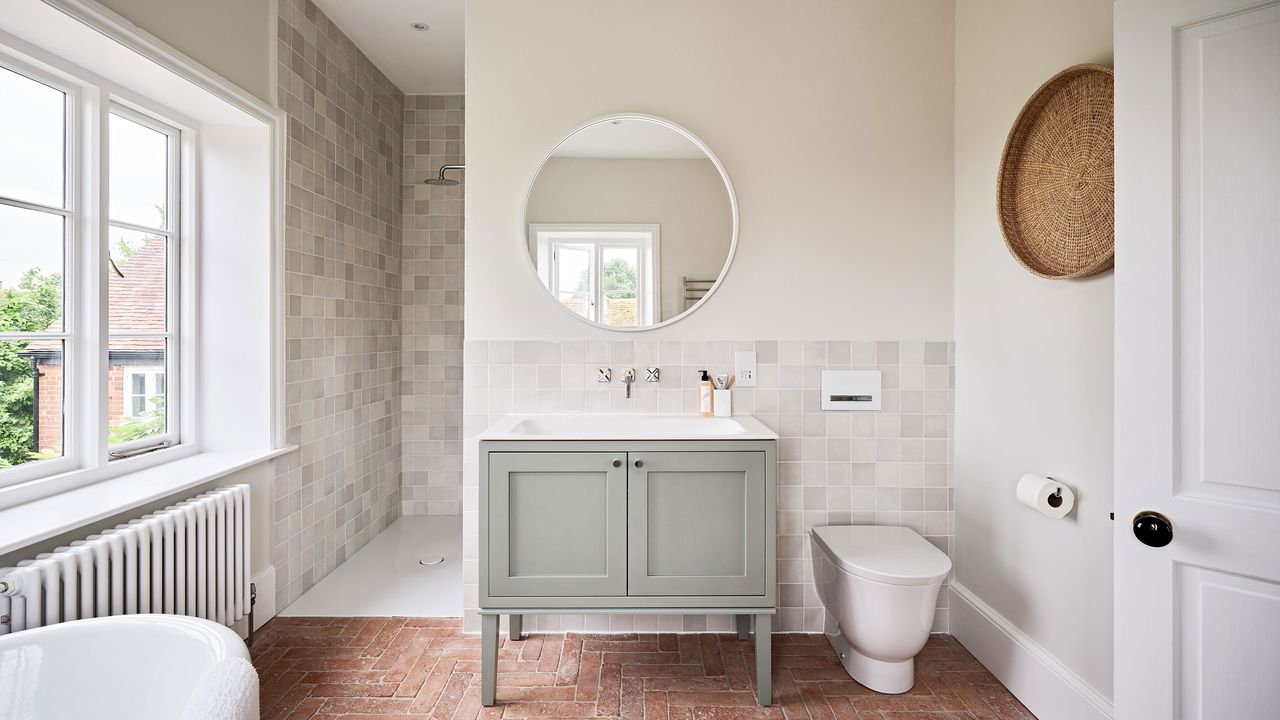

Of all the questions I wish I'd asked before starting my bathroom renovation, how to choose a bathroom radiator that would keep the space warm and the towels dry all year round has to be up there at the top of the list.
One of the most common bathroom renovation mistakes people make is to neglect the planning of their heating. As the owner of an old cottage, things can get pretty chilly at times (in fact, even in summer the house never really feels warm).
If there is one room that benefits from good heating, it has to be the bathroom – the space in which, without getting too graphic, we get stark naked and drench ourselves in water.
I reached out to the experts for their advice on choosing a bathroom radiator to ensure that your bathing space feels comfortable at all times.
Towel warmer or radiator – which is best?
It can be difficult to choose between a heated towel rail or a radiator when it comes to heating a bathroom – but when you look into how much does it cost to replace a radiator it is worth getting this decision right.
In general, the former is usually recommended.
'You’re not limited to specific types of radiators in your bathroom – you can really use any style or design of radiator that you like,' says Rob Nezard, managing director of UKRadiators.com. 'The choice often comes down to personal preference, practical needs and the available space.
'Towel rails are ideal if you want to warm or dry towels while also providing heat to the space,' continues Rob. 'They’re functional and available in a variety of styles and finishes.'
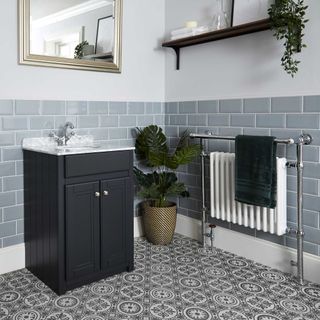
We chose a heated towel rail for our bathroom but I wish that I had thought about the way in which covering it in damp towels would mean less heat entering the room. In retrospect, combining this with electric underfloor heating would have been the best idea.
That said, traditional radiators do have their benefits in the bathroom.
'Heated towel rails are a great alternative to the traditional radiator style. They do what their name suggests, in that they heat your towels, but are not as effective at heating your whole room,' says Shamila Iqbal, director at Bathroom Mountain. 'Standard heated towel rails will connect to the same central heating system as your traditional radiators, but tend to emit less heat.'
'Another thing to keep in mind is that the bigger the bars, the better the heat output,' advises Nick Duggan, director at The Radiator Centre. 'Designs which separate the towels from the radiator section are also great options, as these heat the room more effectively.'
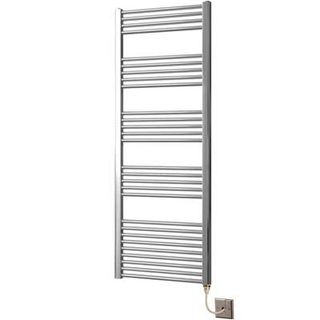
If you are after a good-size, classic-style towel radiator then this one is well worth a look. It is electric so will be easy to retrofit and features layers of copper, zinc and chrome to ensure it will resist rust.
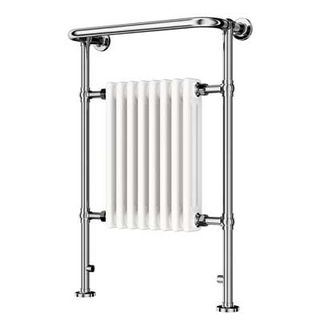
This classic style towel radiator offers all the charm of a column radiator with the benefits of a heated towel rail. It has an output of 1740BTU and is designed to be plumbed in.
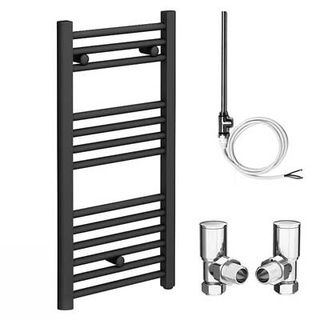
This modern, black model is dual fuel, designed to be plumbed into the mains central heating system. It can also be connected to the electric mains and comes complete with radiator valves and a summer electric heating kit.
What size radiator do I need in my bathroom?
When it comes to what's the most efficient way to heat a house, choosing the right size of radiator or towel warmer for your bathroom is crucial in order to ensure the space is neither too hot or too cold.
This is definitely one thing I wish I'd asked before starting my bathroom renovation. While our heated towel radiator isn't tiny, as a family of four we could really have done with a bigger one to hold all the wet towels we seem to get through.
'To ensure you choose the right size radiator for your space, it’s important to consider room size and the required BTU for adequate heating,' explains Shamila Iqbal.
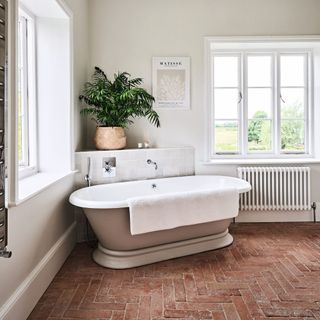
'While it’s true that larger bathrooms generally require larger radiators, insulation and layout play a critical role,' picks up Rob Nezard. 'For example, a large, well-insulated bathroom may need a smaller radiator than a compact, poorly insulated space.'
While there are lots of BTU calculators online, do be wary when it comes to relying solely on these.
'Be aware that there are a lot of so-called 'BTU calculators' online which are simply not fit for purpose,' warns Rob Nezard. 'It is a complex calculation that requires a lot of inputs, so if the calculator seems really simple, then it is probably really inaccurate. You can always consult a heating engineer who will be able to do this calculation for you.
'Tools like our Radsizer offer advanced calculations to help determine the ideal size and output for your bathroom,' adds Rob.
If you can't find a model with exactly the same BTUs you require, opt for the next size up.
What materials are best for a bathroom radiator?

Bathroom radiators and towel warmers come in all kinds of materials and styles, with some being more suited to certain bathroom ideas and interior schemes than others and offering different thermal properties too.
Radiators are generally made from one of four materials: cast iron, aluminium, mild steel or stainless steel. All comes in various designs and finishes to suit your bathroom colour schemes.
'A common pitfall is choosing a radiator solely based on its design and physical size,' points out Rob Nezard. 'While aesthetics matter, functionality is paramount. Prioritise efficiency and output before focusing on looks.'
Cast iron is a traditional choice, often seen on column radiators. It retains heat really well, but is heavier and can take longer to get up to the required heat than other materials. It can also be rather expensive.
Aluminium heats up really quickly and heats most spaces very efficiently. It is lightweight too, although it doesn't hold on to heat well once turned off – not always a bad thing.
Mild steel is a great option if affordability is important to you, plus it comes in many styles.
And, lastly, stainless steel. This is a hugely popular material for bathroom radiators, being rust-proof (perfect for a wet space like this), durable, a brilliant retainer of heat and available in a massive choice of styles.
Is an electric towel warmer the best option?
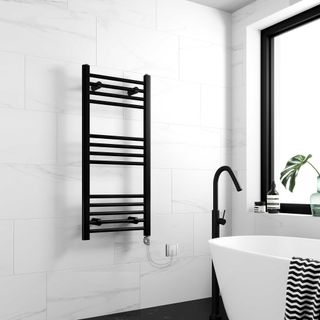
Once you start shopping around for bathroom radiators you will become aware that there are three main choices: plumbed, electric or dual fuel.
Our bathroom towel warmer is plumbed, meaning it works in the same way as all the other radiators in our home connected to the central heating. When the heating is on, the towel warmer is on and when the heating is off, so is it. This annoys me as, even in summer, I want warm towels.
One solution would have been to choose an electric towel warmer instead.
Electric towel warmers can be switched on and off as required. Some come with thermostatic controls which allow you to set a specific temperature or to pre-set them – others even allow you to programme them to come on a certain times of day.
The only downside of these is that they can be a little more expensive to run – plus, you need to remember to turn them on and off, unlike a plumbed in model which simply works in tandem with your central heating.
Be aware that even some of the best electric heaters may not be suitable in bathrooms.
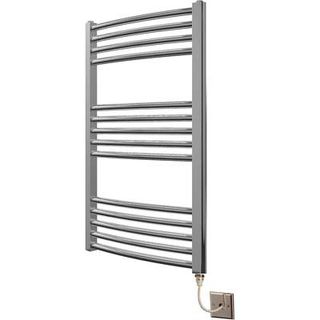
This model would be perfect for smaller bathrooms or a cloakroom, measuring a still-very-useful 500mm x 800mm. It even comes complete with all the fittings needed for installation.
What are dual fuel towel rails?

These types of heating systems really offer the best of both worlds. They contain an electric heating element but are also plumbed in. This means that in winter, when your central heating is on, they will be too. However, when the time comes to turn the central heating off, they can be powered using your electricity instead.
'We would always recommend looking at a dual fuel option when it comes to bathroom heating,' says Nick Duggan. 'Many towel radiators are also now available with an optional electric heating element, which will ensure you have warm and dry towels even when your central heating is turned off in the summer.'
The only downside of this is that you will need to connect both plumbing and a mains electricity supply into your bathroom.
FAQs
What type of radiator is best for a bathroom?
This really depends on what you want from your radiator. For example, if you are after small bathroom ideas, you will want to choose a compact model that is still capable of kicking out enough heat.
'An important thing to consider when choosing a radiator for your bathroom is storage and how much you need to help create a functional space,' advises Jess Steele, heating and technology expert at BestHeating . 'For maximum storage in busy family bathrooms I would recommend ladder style heated towel rails as they offer a larger surface area with multiple rails to hang towels on. If style takes priority over storage, radiator accessories like hooks and rails provide additional space to hang robes and towels on vertical designer radiators, whilst still creating a modern minimal look.
'Where storage is a must but wall space is limited, shelf style heated towel rails offer an extra surface to organise towels and keep them warm without overcrowding a small bathroom.'
Don't rule out underfloor heating either.
'Underfloor heating works on the principle of radiant heat, whereby heat is emitted evenly across the entire floor surface, ensuring consistent warmth throughout the space,' explains Tom Edmunds, general manager at Wunda Group. 'Unlike traditional heating methods that rely on convection, which often result in hot and cold spots, underfloor heating delivers a blissful warmth from the ground up. UFH delivers fantastic comfort within the bathroom particularly due to just how well it pairs with tiles.'
Should bathroom radiators have thermostatic valves?

If your bathroom radiator is going to be plumbed into your central heating system it will need valves.
'All plumbed radiators require radiator valves,' says Shamila Iqbal. 'These are purchased separately from the radiator – and it’s important that you choose the right valves for the job.
'Do you need a straight valve or angled valve?' continues Shamila. 'Generally speaking, if your heating pipes come out of the floor you will need straight valves. If they come out of the wall, it’s angled valves.'
Manual valves, as the name suggests, require you to adjust them by hand to control the temperature of the radiator.
More popular these days are thermostatic radiator valves (TRVs). These sense the temperature of the room and adjust the heat output of the radiator accordingly. You can also adjust them by hand.
If you want even more of a hands-off role, consider a smart thermostat. These can be controlled via smart hubs or devices and offer all kinds of handy, life-simplifying features.
Choosing the right radiator is just one aspect of getting your bathroom ideas just right – layout, your choice of sanitaryware and lighting are all other important considerations.
Get the Ideal Home Newsletter
Sign up to our newsletter for style and decor inspiration, house makeovers, project advice and more.

Natasha has been writing about everything homes and interiors related for over 20 years and, in that time, has covered absolutely everything, from knocking down walls and digging up old floors to the latest kitchen and bathroom trends. As well as carrying out the role of Associate Content Editor for Homebuilding & Renovating for many years, she has completely renovated several old houses of her own on a DIY basis.
-
 This is the best value for money Le Creuset dish shape – here's why you should buy it over the classic round casserole
This is the best value for money Le Creuset dish shape – here's why you should buy it over the classic round casseroleI thought I already owned the ultimate Le Creuset dish until I bought this particular shape. Here's why
By Molly Cleary
-
 Can you revive woody lavender plants? Experts reveal the best way to do it and how to tell if your plants are past their best
Can you revive woody lavender plants? Experts reveal the best way to do it and how to tell if your plants are past their bestIf you don’t tend to lavender plants properly, things can get messy – fast!
By Kayleigh Dray
-
 How to clean a mattress gently – cleaning experts say all you need is a pan lid
How to clean a mattress gently – cleaning experts say all you need is a pan lidThe pan lid mattress cleaning hack is a gentle way to clean your mattress
By Kezia Reynolds